Interior decoration of the house is the final step in construction. It is carried out after the completion of the construction of the roof, facade cladding. The choice of material and the technology of its attachment depends on the style of the interior, the functionality of the room, and the features of its operation.
- Varieties of interior decoration for the home
- Rack
- Covering
- Rolled polymer
- Paints and varnishes
- Plaster
- Slab
- Sheet materials
- Fundamental rules
- Design
- Nuances when choosing a finishing material
- Required tools and materials
- DIY step-by-step instructions for interior decoration of a house
- Ceiling decoration
- Wall decoration
- Floor decoration
Varieties of interior decoration for the home

For the interior decoration of a private house, synthetic and natural materials are used. Many interior designs allow you to combine different coatings.
Rack
The group of lath materials includes edged board, lining (wood and plastic), PVC panels. They allow you to quickly cover large areas. The products are generally durable, resistant to mechanical stress. Wooden elements do not tolerate moisture well, therefore they require additional protective treatment.
Covering
Covering materials include vinyl, linoleum. These materials are easy to clean and practical. With proper installation and operation, their service life is at least 10 years. Due to the low cost, such materials can be afforded by a person with any income. However, vinyl and linoleum must be combined with other materials. They impair air exchange after installation. In addition, such coatings are not recommended for use in rooms with high humidity.
Rolled polymer
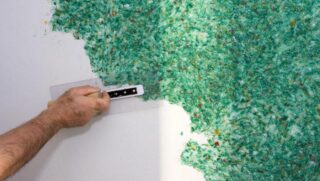
This group includes wallpapers. Modern types of this material are capable of imitating various natural surfaces. Wallpaper can be vinyl, paper, liquid, bamboo. They are characterized by a wide selection of textures, textures, standard sizes, shades. The cheapest paper option. However, it is unstable to moisture and when dirt appears, it will not be possible to remove it. Glass wallpaper, photo wallpaper, non-woven and metallized varieties are also used to decorate the house inside. When using them, high-quality leveling and priming of the base is required.
Paints and varnishes
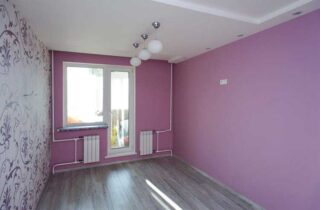
The advantage of such a coating is the variety of types that can be used both in living rooms and in technical rooms. For interior decoration, the following compositions are used:
- Acrylic. After application, a strong film forms on the walls, which repels moisture. They are characterized by bright colors and saturation. The disadvantage of the material is the inability to pass air.
- Water-based. Most of all, this paint is suitable for living rooms, since it is water-based and does not contain volatile toxic components.
- Silicone. This finishing option is expensive, but it creates a durable finish that can hide even minor irregularities and imperfections.
- Latex. Such compositions show themselves well in bathrooms, in the kitchen. The wall surface becomes resistant to dirt.
A good option for decorating a brick or timber house is alkyd paint. It is highly resistant to wear and tear and creates a durable decorative layer.
Plaster
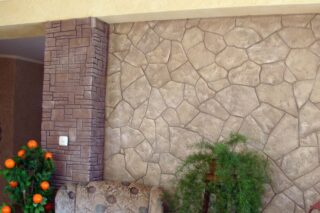
To decorate a brick house from the inside, different types of plasters are often used: embossed, mineral, structural or smooth. They are suitable for decorating aerated concrete walls. Some types of plaster can be used outdoors. This finish provides sound insulation and is inexpensive. It can be multi-colored. However, you need to use the material correctly. Failure to comply with the technology will lead to peeling of the layer, its cracking.
Slab
This group includes bricks, ceramic tiles, natural (artificial) stone. They are suitable for both facade decoration and interior work. For the installation of the material, certain skills are required, as well as preliminary marking, layout of the picture. The tiles are laid on the floor and walls. The stone is best used to decorate small fragments.
Sheet materials
Log houses from the inside can be decorated with wooden or plastic (provided a ventilation gap is created) panels. This finish is also suitable for a foam block. The material is easy to install and operate. However, to fix it, a crate is required, which takes up useful space. Facing works are fast, without wet processes and dirt. Utilities and wiring can be hidden under the trim. For finishing the frame house inside, drywall is used.
Fundamental rules
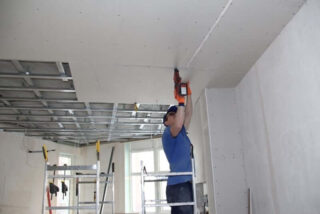
To make the interior decoration of a brick house or wooden structure, you must follow these recommendations:
- Before starting finishing work, lay the wiring and all communications.
- All the “dirty work” is finished before the inner lining.
- If the house is frame, each room must be tiled separately: in the rest of the rooms, repairs are not started.
- It's better to start work at the farthest corner and move towards the exit.
- The first is to finish the ceiling, the last is the floor.
Before using the selected material, it must be left in the house for 2-3 days so that it “gets used” to the conditions.
Design
Getting started, it is better to draw a scheme for decorating a room with an indication of the dimensions and characteristics of load-bearing walls, partitions, the arrangement of pieces of furniture, plumbing fixtures. In the drawing, the exact markings of the cladding on the walls and floor are drawn. Be sure to highlight the location of lighting devices on the stream, additional structures, if any.
The project includes the location of communications and electrical wiring, ventilation system. Thanks to the drawings, you can calculate the exact amount of materials, the amount of repair and installation work.
Nuances when choosing a finishing material
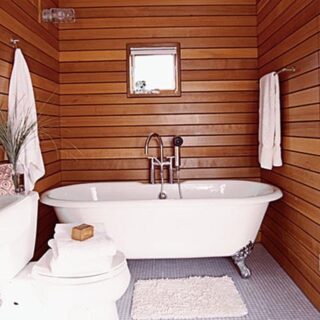
The cladding of a house from a log, brick or aerated block is made taking into account the characteristics of the selected material.
- Do not use MDF panels or plastic in rooms where people live permanently. They do not provide an optimal microclimate and prevent proper air exchange.
- If the material is intended for cladding the outside of a wall, it must not be used for interior cladding.
- If the building is built from an aerated block, plasterboard structures can be used for decoration.
- It is not recommended to install wooden lining and panels in the bathroom; in addition, the elements are treated with protective compounds.
When using cladding with a relief, you need to take into account that it will be difficult to care for them.
Required tools and materials
The selection of tools depends on the used finishing material. The standard list includes such devices:
- jigsaw;
- hammer drill or hammer drill (for brick and concrete walls);
- hammer, pliers;
- various screwdrivers;
- measuring tape, marker, cord for breaking the level, plumb line;
- building level;
- square;
- stapler and staples;
- devices for smoothing wallpaper;
- spatulas, trowel and float (if plaster or putty will be used);
- mallet (for laying laminate).
Of the materials, insulation, a vapor barrier film, and waterproofing are required. For fixing wallpaper, laminate, parquet boards, a suitable adhesive is required. When preparing the base, a primer mixture, antiseptic compositions for wood are used. The lathing is built from slats or aluminum profiles. Self-tapping screws, dowels are used as fasteners.
DIY step-by-step instructions for interior decoration of a house
The cladding of all surfaces in the room must be combined with each other, fit into the chosen interior concept.
Ceiling decoration
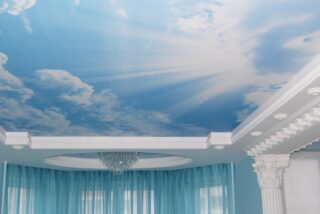
Working with the ceiling is not very convenient, since you have to use a stepladder and move it from place to place. Finishing is carried out with plaster, putty, followed by painting the surface, stretch ceiling or plasterboard structure. The work includes the following stages:
- Substrate preparation: cleaning of old cladding, leveling, filling of deep flaws and cracks.
- Ceiling priming.
- Applying a layer of putty or plaster, forming a lathing for a plasterboard structure or a frame in which a stretch ceiling is installed.
The ceiling made of gypsum fiber board is putty, primed and painted with water-based paint. Lighting devices are installed in the structure. The wires are hidden in corrugated insulating tubes.
Wall decoration
In this case, finishing also begins with the preparation of the base. Before wallpapering or painting, the walls are leveled and treated with soil. For fastening PVC panels, adhesives or lathing are used. The wooden lining is attached to the slats. If necessary, the walls are insulated. Stone wool is attached to a waterproof film, and on top of it - a vapor barrier membrane.
Floor decoration
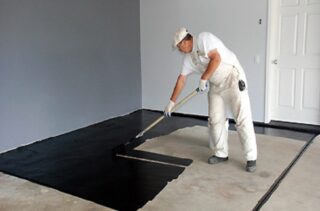
The process of interior flooring includes the following stages:
- installation of a rough base;
- waterproofing film flooring;
- laying insulation;
- fastening the rough layer of boards or plywood to a concrete base or logs;
- grinding the flooring, cleaning it from dust;
- laying of facing material: linoleum, laminate, tiles.
Each type of finishing material has its own technical characteristics, operating features. All the nuances of using the cladding are taken into account before starting the repair.








